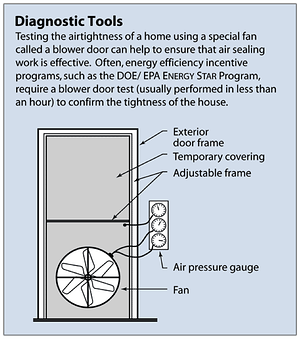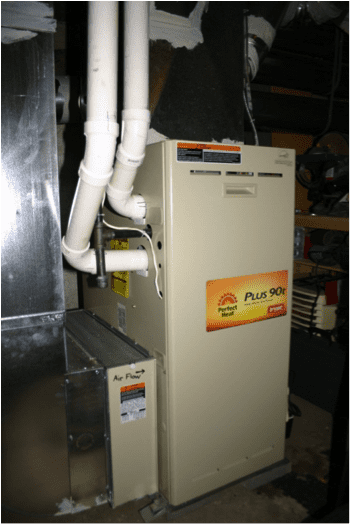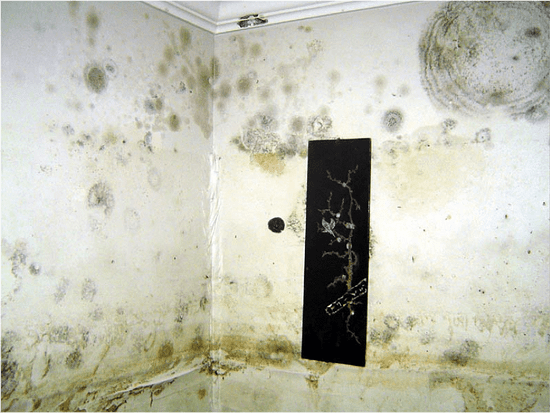 I am an energy auditor and weatherization contractor working primarily in the residential market in Central Pennsylvania. Through a variety of tests, I can tell a homeowner not only what home improvements should be done to improve the efficiency of the home, but also what the return on investment will be. Apart from the energy savings, I also pay particular attention to the health and safety of the home.
I am an energy auditor and weatherization contractor working primarily in the residential market in Central Pennsylvania. Through a variety of tests, I can tell a homeowner not only what home improvements should be done to improve the efficiency of the home, but also what the return on investment will be. Apart from the energy savings, I also pay particular attention to the health and safety of the home.
Energy auditing and building analysis is a fairly new industry. I received my training in Maine, through Maine Housing, and at the Weatherization Training Center at Penn College. I also went through the Building Performance Institute's Building Analyst certification.
I would like to share some of the tricks of my trade with the PeakProsperity.com community. I will also share an average of the return on investments that I have seen on my jobs. As I go through a home, these are the items I typically look at:
- The building shell (air sealing)
- Insulation
- Combustion analysis (furnace or boiler analysis)
- Ducts
- Water heater
- Lighting
- Base load appliances
- Water conservation
- Health and safety
- Phantom loads
- Solar
- Windows and doors
The Building Shell (Air Sealing)
All homes have an air barrier, but some are, of course, better than others. An air barrier basically helps to reduce the amount of conditioned air that is lost and replaced by unconditioned air. The faster a building exchanges air with the outside, the more energy is needed to maintain the structure at a comfortable temperature. There are always holes in your air barrier, because otherwise you would suffocate in your home. The trick is to keep the number of holes to an acceptable level without compromising safe and healthy ventilation.
I use a blower door, which is essentially a door frame, tarp, and fan that goes in an exterior door, hooked up to a pressure manometer. Basically, this test gives me the CFM leakage of the structure at 50 pascals of pressure. While the fan is running, I can typically find leaks using various techniques and equipment. Based on the structure, the leakage number, and the subsequent tests, I then determine if it is safe to seal up the house further, where to seal, and what potential savings are to be gained.I would not recommend performing air sealing on a house without having a blower door test done by a BPI certified Building Analyst. For example, maybe your house is right on the border of allowing mold to develop. You proceed to seal the house too tight, and mold begins to develop in the bathrooms or kitchen. Perhaps you have many pets and odors that are tolerable with your leaky house when they are quickly exchanging with the fresh outdoor air, but then you seal the house up to a point where the smells become unbearable. Or you might encounter the biggest fear of any building analyst, the possibility of a backdrafting flue causing carbon monoxide poisoning.
In my experience, older homes tend to be leakier than new homes. Air sealing in the attic is typically the best place to start. Recessed lights, plumbing chases, wire intrusions, open wall cavities, and attic hatches are common leakage points. If you are sealing a recessed light, make sure you follow local fire code.
If you would like to learn more about specific air sealing techniques, the Department of Energy link below has some good information at this site.
ROI on Air Sealing – AVG 18%
(It really varies on the structure, energy prices, how difficult the air sealing techniques are, and how good your contractor is at finding and sealing the biggest leaks. The materials are usually inexpensive, but can use a lot of labor)
Insulation
Your thermal barrier, or insulation, will determine the ability of your home to retard heat flow. The slower your heat leaves your home, the less energy your heating system will use. Your air barrier and thermal barrier should be together and continuous for maximum efficiency. It is very important that you air seal before installing new or additional insulation. Insulation is another job I would recommend hiring a BPI certified building analyst before tackling.
The typical insulation install in an existing home is installed in the attic. Sidewalls and rim joists can also be done in certain homes. It is important to do the proper attic prep before adding any insulation. This may include the following:
- Determine amount (In PA, code is R-38: about 11 inches of blown cellulose or fiberglass.)
- Check electrical (Watch out for knob and tube wiring, or any frayed wires or overburdened junctions.)
- Make insulated boxes to go over any non-IC-rated recessed lights
- Metal flashing with fire-safe caulk to keep insulation away from chimney or flue
- Air sealing all intrusions into attic (If air sealing is not done, condensation can occur in attic, leading to mold, derated insulation, and ice dams.)
- Ventilation (Make sure soffit vents have proper vents to train air flow to ridge vent and also make sure blocking is installed to prevent new insulation from clogging vents. Installing insulation without proper vents and blocking can lead to wind washing that will derate your insulation.)
- Dams may need to be installed to prevent insulation from spilling over attic hatches, air handlers, and vents
- Any roof leaks must be addressed
- Watch out for vermiculite, as it has been known to contain asbestos, which can cause cancer. It should be removed by an asbestos-removal contractor.
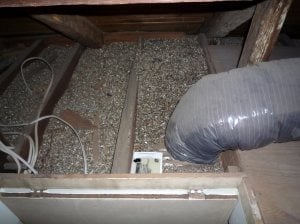
(photo: vermiculite)
Blowing sidewalls and floors can be a very difficult job, and the only houses that typically make sense to do this in are those without insulation that have large wall cavities and balloon framing. This is definitely a job for the professionals.
Rim joist insulation can be an effective install for those homes with uninsulated rim joists. Below is a nice video that shows where the rim joist is. A homeowner or even a contractor can simply use rigid board insulation, friction fit and foamed on the edges with cans of spray foam, for sufficient improvement. The more expensive spray foam with the large canisters in the video is not necessary.
http://www.youtube.com/watch?v=jLGbmjFgL9k
I personally prefer to use loose blown cellulose insulation. It is essentially recycled newspaper. I prefer this to fiberglass as it is non-toxic, resists air, and will seal small air leaks, where fiberglass will not stop air and is quickly derated when windwashing is present. I do use fiberglass on occasion, and it is certainly an effective form of insulation. Closed-cell foam insulation is the "new kid on the block." It is a perfect air barrier with a high R value, but it is expensive. It is a good to use if you are insulating a roof deck where you are bringing the entire attic inside the thermal envelope; for example, when you have ducts and an air handler in the attic.
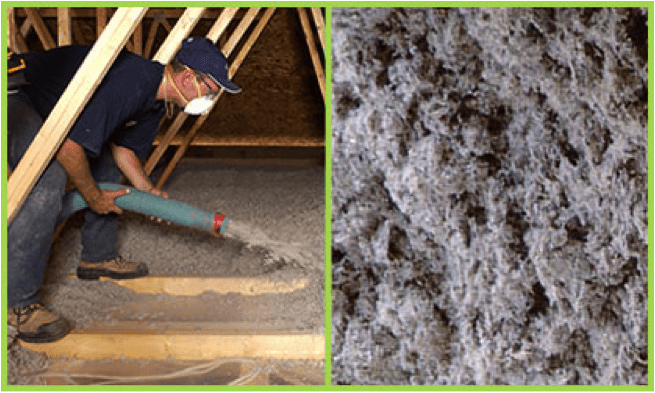
(photo: Cellulose Insulation)
ROI on insulation: AVG. 17%
(Varies depending on difficulty of the install, and how much insulation there is. The less existing insulation there is, the higher the ROI.)
Combustion Analysis (Furnace or Boiler analysis)
I do a combustion analysis on Oil and Gas systems to determine efficiency, draft, CO, O2, among other things. Typically the 80% + systems and below will progressively lose efficiency after they have been tuned. It is a good idea to have your system professionally maintained. It really does make a big difference.
Oil boilers and furnaces: The best systems are typically 85% efficient. If you have an older system, it could be around 60% or 70% efficiency. If you have an older system, I would highly recommend discussing replacement with your HVAC professional. If no natural gas is available and you have the funds, switching to a geothermal heat pump is a great way to go. It is on the pricey side, as I have seen systems for 30K, but paybacks can approach 10%, depending on how much oil you are using.
Gas Furnaces or Boilers: Natural gas is so cheap right now, and the high efficiency 95% + units are affordable and extremely efficient. This is a nice option if you have a natural gas line that you can tap into. If you have an older 70%+ unit, a high efficiency replacement unit can give you a 10-15% payback, and with the sealed combustion, CO is no longer a major concern.
Electric Resistance Heat: This is by far the most expensive way to heat a house. It is a great idea to switch to natural gas if you have access to a gas line, or to geothermal if you have the funds. High-efficiency natural gas units can yield a 20% ROI, while a geothermal heat pump can yield a 10% ROI.
Size really does matter: One problem in almost every home that I audit is that the heating system is oversized. Does your system frequently turn on and off? Or does it run constantly? A perfectly sized system will run constantly on a cold day. A perfectly sized system will not be able to heat your house to 72 degrees on the coldest day of the year. Combustion heating systems run at their maximum efficiency at steady state. When a system starts and stops, it runs at a much lower efficiency than the unit’s rated efficiency. Fantastic savings can be gained by air sealing and insulating, thereby reducing the heating load on a home, and then the heating system can be replaced with a smaller, more efficient system.
(photo: 90% + condensing furnace)
ROI on heating system replacements: 7%-25%
(Varies dependent on how inefficient the current system is, what fuel source, rebates, and cost.)
ROI on tune up for combustion equipment: 50%
(Possibly more depending on how out-of-tune your equipment is.)
Duct Sealing and Insulation
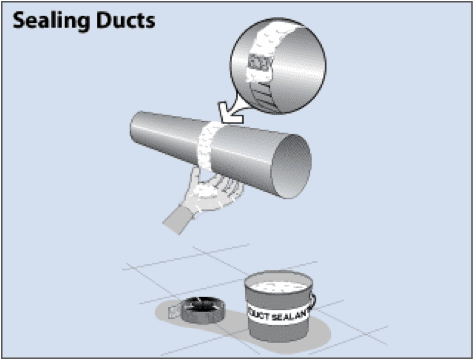 If your ducts are entirely inside the thermal envelope, or conditioned area, this is typically not a problem. You can seal ducts in this situation to help balance your furnace. This becomes critical when you have ducts in a crawl space or attic. Any leaks in the ducts will help to heat that attic or crawl space. This can, of course, waste energy, but it can also lead to condensation issues, as the conditioned warm air hits the cool roof deck or crawl space. A very easy fix for sealing your ducts is to use duct mastic to seal up all the joints and connections. Mastic is good because it does not come off like tape and can expand and contract. It is a paste that can be spread with a brush or just an old glove that you are willing to sacrifice.
If your ducts are entirely inside the thermal envelope, or conditioned area, this is typically not a problem. You can seal ducts in this situation to help balance your furnace. This becomes critical when you have ducts in a crawl space or attic. Any leaks in the ducts will help to heat that attic or crawl space. This can, of course, waste energy, but it can also lead to condensation issues, as the conditioned warm air hits the cool roof deck or crawl space. A very easy fix for sealing your ducts is to use duct mastic to seal up all the joints and connections. Mastic is good because it does not come off like tape and can expand and contract. It is a paste that can be spread with a brush or just an old glove that you are willing to sacrifice.
Ducts in unconditioned spaces should be insulated to R-11. It is possible to lose 10-30% of a home’s heating and cooling energy through the conduction of uninsulated ducts.
ROI on duct sealing: AVG 14%
(Varies on fuel type, prices, accessibility, but also offers many residual benefits to the HVAC.)
ROI on duct insulation: AVG 22%
(Varies on fuel, prices, job difficulty.)
Water Heaters
The first thing to look at is the temperature. 120 degrees usually works well. Make sure your water is not hotter than that. You can check the water heater, as some do have settings, but you may have to put a thermometer under hot water to find out. Constantly keeping a tank at too high a temperature is extremely expensive.
The second thing to be concerned about are the water pipes. Are they insulated? If not, insulate starting from the tank, 6’ on the cold side, and as much of the warm side as you can reach. This will help you reduce standby loss, and it is super easy and cheap also. In some situations water heater tank wrap can also be installed, but be careful because in some water heaters, a wrap will void the warranty. Make sure to check the manual to find out if a wrap is appropriate. Most new water heaters are already insulated.
Should you consider replacement? If you have an electric water heater, I would strongly recommend the new air source heat pump water heaters. They use less than half the electricity of a traditional electric water heater. Solar hot water is another nice option, especially those that are concerned about steady supplies of traditional energy in the future. On-demand tankless systems work well if you use natural gas for your water heating, especially if you are moving from an inefficient tank model (non-condensing unit, atmospherically vented). However, with natural gas so cheap, the ROI is not great, and if you have a heavy hot-water need, you may need more than one.
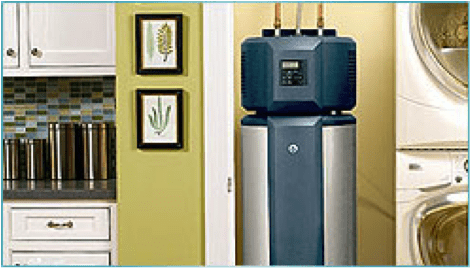
(photo: Air Source Heat Pump Water Heater)
ROI pipe insulation- AVG 27%
(Big ROI because improvement is so cheap)
ROI new air source heat pump water heater- AVG 23%
ROI Solar hot water- 7%-15%
(Varies based on fuel, can be higher with rebates)
ROI tankless Gas- 4%-7%
(Varies based on type replacing, fuel prices)
Lighting
Incandescent, CFL’s, or LED’s are the predominant lighting choices available to most homeowners.
|
Type |
Pro’s |
Con’s |
|
Incandescent |
Dims well; cheap; most people like the quality of the light |
Not efficient; emits waste heat. Does not last long. |
|
Compact Fluorescent |
Affordable; uses 20% of the electricity of an incandescent |
Mercury inside if broken. Some people do not like the quality of the light. |
|
LED |
Extremely long-lasting; uses 1/3 the electricity of a CFL |
Very expensive; some people feel the light is too dim. |
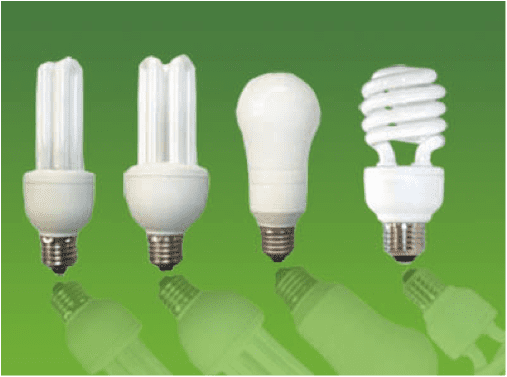
ROI CFL’s- AVG 96%
(Depending on how many hours per day the light is used)
ROI LED’s- AVG 16%
(Depending on how many hours per day the light is used)
Appliances
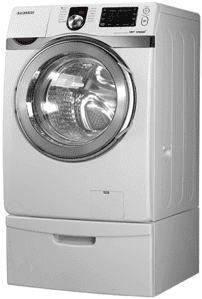 There are only a couple of appliances that I am concerned about considering replacing, as far as efficiency goes. The number one appliance is the fridge/freezer. The second would be the washing machine, and a distant third and fourth would be the dishwasher and the non-energy-star dehumidifier. Here is a link to a nice database for refrigerators and freezers to give you an idea of how many KWH of electricity your current unit is using. Compare that to a new unit’s yellow energy sticker to determine the savings you would receive by replacement. Then, based on the cost and potential energy savings, you can easily decide if replacing your appliance is a good investment. Stay away from side-by-side fridges with built in icemakers, as they are more expensive and less efficient than typical top-freezer models.
There are only a couple of appliances that I am concerned about considering replacing, as far as efficiency goes. The number one appliance is the fridge/freezer. The second would be the washing machine, and a distant third and fourth would be the dishwasher and the non-energy-star dehumidifier. Here is a link to a nice database for refrigerators and freezers to give you an idea of how many KWH of electricity your current unit is using. Compare that to a new unit’s yellow energy sticker to determine the savings you would receive by replacement. Then, based on the cost and potential energy savings, you can easily decide if replacing your appliance is a good investment. Stay away from side-by-side fridges with built in icemakers, as they are more expensive and less efficient than typical top-freezer models.
Front-load washing machines use a lot less water, water heat, and electricity than top-load washers. Whenever replacing a top load, pick an energy star front load. Dishwashers should only be replaced for an energy-star model if you have a pre-1994 model. Otherwise, use it until it breaks. Non-energy-star dehumidifiers are a good item to replace, but it would be even better to remove the source of the moisture so that you do not need the dehumidifier whenever possible.
Fridge Replacement: AVG 21%
Washer Replacement: AVG 11%
Dishwasher Replacement: AVG 8%
Dehumidifier Replacement: AVG 9%
Water Conservation
Low-flow showerheads, faucet aerators, and low-flow toilets are a great way to save water, along with whatever fuel you are using to heat your water, as well as your sewer bill. Most showerheads will tell you on the head how many GPM they allow to flow. Low-flow showerheads typically allow 1.5 GPM. If you have a showerhead with 2.0 GPM of flow or higher, it is a good idea to replace it with a low-flow showerhead. Bear in mind that you will have less pressure and water with a low-flow head, although the new designs do a good job of aerating the water. Low-flow faucet aerators are also 1.5 GPM. It is a good idea to replace the aerators that are 2.0 GPM or higher. The aerators are super cheap, and you will not sacrifice anything to achieve the water savings.
Low-flush toilets typically use 1.6 gallons per flush, although I have seen lower, while older toilets can use 3.5 GPF. There are also dual-flush toilets that allow even lower GPF for liquid waste. Switching to a low-flow toilet can save 20,000 gallons of water per year. Composting toilets are a good solution for those off the grid, or who want to remain independent of the public sewer.
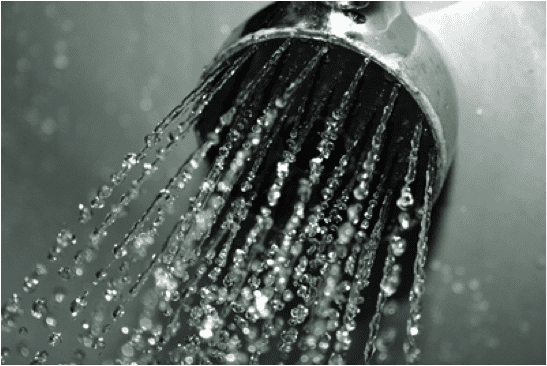
(photo: Aerated water)
ROI low flow showerhead: AVG. 50%
(Varies, dependent on fuel source, water prices, GPM of former head, and water use)
ROI Faucet Aerators 1.5GPM: AVG. 70%
(Varies, dependent on fuel source, water prices, GPM of former head, and water use)
ROI low flow toilet 1.6 GPL: AVG. 28%
(Varies, dependent on water prices, former GPF amount, and sewer)
Health and Safety
CO and moisture/mold are the two biggest things that I am concerned about, as far as health and safety, when I am looking at a house. I can always tell who has a wet basement when I drive by a house and see relatively new paint peeling off. This is from the vapor pressure of the moisture. Excess moisture will literally take years off the life of your home. Below is a list that I give my clients to help them to keep their house safe, healthy, and durable.
Living in a healthy home and avoiding mold and mildew:
- Avoid unvented space heaters
- Don't overcool the house in the summer
- Don't hang drying clothes inside
- Don't dry wood indoors (no storing firewood inside)
- Use kitchen and bath fans at least 3x the duration of shower or cooking
- Enhance room circulation with fans to avoid cold spots
- Avoid storing items against cold outside walls or in damp basements
- Avoid storing vulnerable materials in damp basements
- Run a humidistat equipped dehumidifier during summer in damp basements
- Additional pets and people add moisture; be aware of increased ventilation needs if adding occupants.
- New construction adds tremendous moisture to home for the first years as materials are drying
- Make sure dryer is always vented outside
- Never store the following inside: paints, solvents, grease, oil, pesticides, gas equipment, kerosene space heaters
- Don’t warm your car up in the garage, if garage is attached to the house.
- Beware of too many house plants, as they can add a lot of moisture to the home
- Make sure drain pipes are functional and sent away from the foundation (also keep gutters clean)
- Have heating equipment professionally maintained
(photo: mold in a bathroom)
Phantom Loads
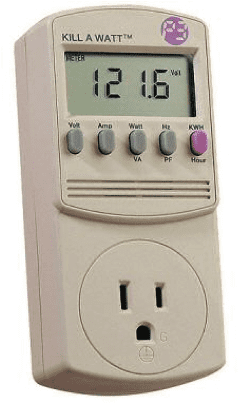 Many appliances will draw electricity while plugged in but not in use. The trick is to find out which ones are drawing enough power to be concerned about either unplugging them or putting them on a power strip that you turn off. I use a handy tool called a watt meter to determine this. You can buy one for about $40. You plug the appliance into the watt meter and the meter into the outlet. Then read the results after it has had enough time to make a good yearly projection. Older televisions tend to be the biggest offenders that I find. People also tend to have these old TVs plugged into areas where they never use them, like the exercise area in the basement that they use twice a year. I have seen old TV’s that can use 400 KWH just sitting there plugged in for a year.
Many appliances will draw electricity while plugged in but not in use. The trick is to find out which ones are drawing enough power to be concerned about either unplugging them or putting them on a power strip that you turn off. I use a handy tool called a watt meter to determine this. You can buy one for about $40. You plug the appliance into the watt meter and the meter into the outlet. Then read the results after it has had enough time to make a good yearly projection. Older televisions tend to be the biggest offenders that I find. People also tend to have these old TVs plugged into areas where they never use them, like the exercise area in the basement that they use twice a year. I have seen old TV’s that can use 400 KWH just sitting there plugged in for a year.
|
Items that tend to use a lot of power at rest |
Items that do not use much at rest |
|
TV’s, especially older ones |
Toasters |
|
DVR’s, cable boxes |
Phone Chargers |
|
Older Computers |
Printer (must be turned off) |
|
Old Fashioned Jukebox |
Microwave |
|
TV/ VCR combos |
Playstation 2 |
|
|
Clocks |
ROI phantom load removal: 200% AVG
(Does require some occupant discipline to turn off power strips when not in use)
Solar Power Photovoltaic
I did sell some solar systems prior to the PA Sunshine rebates running out, and the ROI factoring in the 30% federal tax credit, the sunshine rebate, and the AEC’s (alternative energy credits) were excellent. I was getting about a 16% ROI on solar systems at this time. Now, with the PA Sunshine rebates no longer available, and the AEC’s dropping like a stone in recent months, the ROI has come down considerably. Having said that, I still think it is a viable investment, especially if you take into consideration the added resiliency. Below is an example of the current ROI on a 10 KW system without a battery backup:
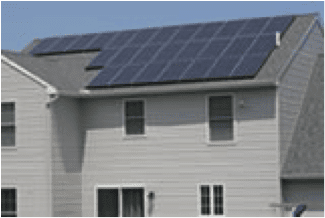
(photo: 10 KW Sunpower roof mounted)
- $7.00 per watt
- cost = $70,000
- Federal Tax Credit= $21,000
- Adjusted Price= $49,000
- PA power production: Appx. 12 MW per year (Provided full sun site, good pitch, and direction)
- Electricity saved= $1800 per year at .15 per KWH
- AEC’s: $1704 per year at current depressed rates
- Savings: $3504 per year
ROI: 7.19%
Doors and windows
I have never sold a new window job, because the ROI is always terrible. The window industry certainly has some great advertising, because more often than not I have clients who think they need new windows. If you have old wood-frame single-pane windows, you are better off caulking, weatherstripping, and adding storm windows. If you already have double-pane or better windows, then simply caulking and weatherstripping, if needed, are sufficient. Doors are in a similar situation; just weatherstrip and make sure the door sweep is in good condition. The only time I would replace a door is when an interior door is used as an exterior door, but even then the ROI is not great. This is sometimes true if you have a door to the attic or to the garage. I have done the ROI calculations for window jobs for those past clients who would not take my word for it. See below:
ROI new windows: 3% AVG
Conclusion
Many utilities across the country and the federal government are offering rebates for energy-efficient measures and appliances. In PA, in accordance with Act 129, the utilities are offering big rebates for whole-house energy audits from participating contractors, as well as rebates for energy saving retrofits. As electricity, fuel oil, and natural gas get more expensive in a world of decreasing natural resources, the detailed improvements listed above will increase their effective ROI. I can’t imagine investing in anything until I took advantage of the great investment opportunities in my own home and infrastructure. As a bonus, you don’t have to worry about Goldman front-running you or the Fed printing too much insulation!
Phil Williams
BPI Certified Building Analyst, Energy Auditor
This What Should I Do? blog series is intended to surface knowledge and perspective useful to preparing for a future defined by Peak Oil. The content is written by PeakProsperity.com readers and is based in their own experiences in putting into practice many of the ideas exchanged on this site. If there are topics you'd like to see featured here, or if you have interest in contributing a post in a relevant area of your expertise, please indicate so in our What Should I Do? series feedback forum.
If you have not yet seen the other articles in this series, you can find them here:
- A Case Study in Creating Community (SagerXX)
- <a href="https://www.pe
This is a companion discussion topic for the original entry at https://peakprosperity.com/how-to-increase-the-energy-efficiency-of-your-existing-home-2/
